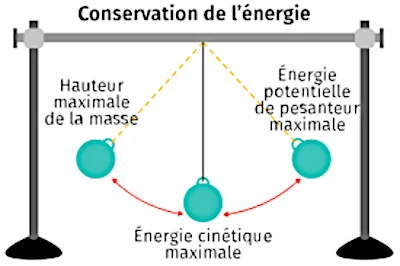
Image: The conservation of energy is a fundamental principle in physics. The total energy of an isolated system, which does not interact with its surroundings, remains constant over time. It can neither be created nor destroyed, but it can be transformed from one form of energy to another.
However, a pendulum in vacuum subject to no frictional force could theoretically have perpetual motion. But even in space, a moving pendulum will continue to lose energy (internal friction of the pendulum itself, transmission of energy to other systems, influence of temperature, etc.). This loss of energy will eventually stop the pendulum. It is therefore not possible to have an object in perpetual motion without any external energy source to compensate for these energy losses.
Kinetic energy is a fundamental property of physics. It is a form of energy associated with the movement of an object due to its speed. Kinetic energy is a scalar quantity, that is to say it has a magnitude, but no direction, it is a quantity that is defined only by a number.
When a pendulum is in motion, it continuously exchanges energy between its kinetic energy (associated with its motion) and its potential energy (associated with its position). With each swing of the pendulum, the total energy of the system (sum of its kinetic energy and its potential energy) remains constant, although energy is continuously transferred between the two forms of energy.
The concept of kinetic energy introduced under the name of "live force" of an object was found by Leibniz (1646-1716) and Émilie du Châtelet (1706-1749).
The equation is:
E_c = ½ mv^2, where E_c represents the kinetic energy, m is the mass (kg) of the object and v is its speed (m/s).
The kinetic energy therefore depends directly on ½ of the mass and the square of the speed of the object. This is why faster or heavier vehicles generally need more energy to maintain their motion.
Potential energy is a form of energy associated with position in the gravitational field. The higher the object, the more potential energy it has. This energy is exploited every day in the hydrolic dams.
The equation is:
E_p = mgh
The potential energy therefore depends directly on the mass of the body m (kg), the gravity g (9.81 m/s2) and also the height h (m) where it is located relative to a reference level.
Potential energy can be converted into other forms of energy, such as kinetic energy (associated with motion) or thermal energy (associated with heat), through appropriate physical processes. For example, an object in free fall converts its gravitational potential energy into kinetic energy as it accelerates toward the ground.
mgh = ½mv^2
v^2 = 2gh (the mass disappears and therefore has no importance in the fall of a body in the void)
h = ½g v^2
note: Potential energy is a relative quantity and depends on the choice of a specific reference position, and only the difference in potential energy between two positions is significant for the calculations.